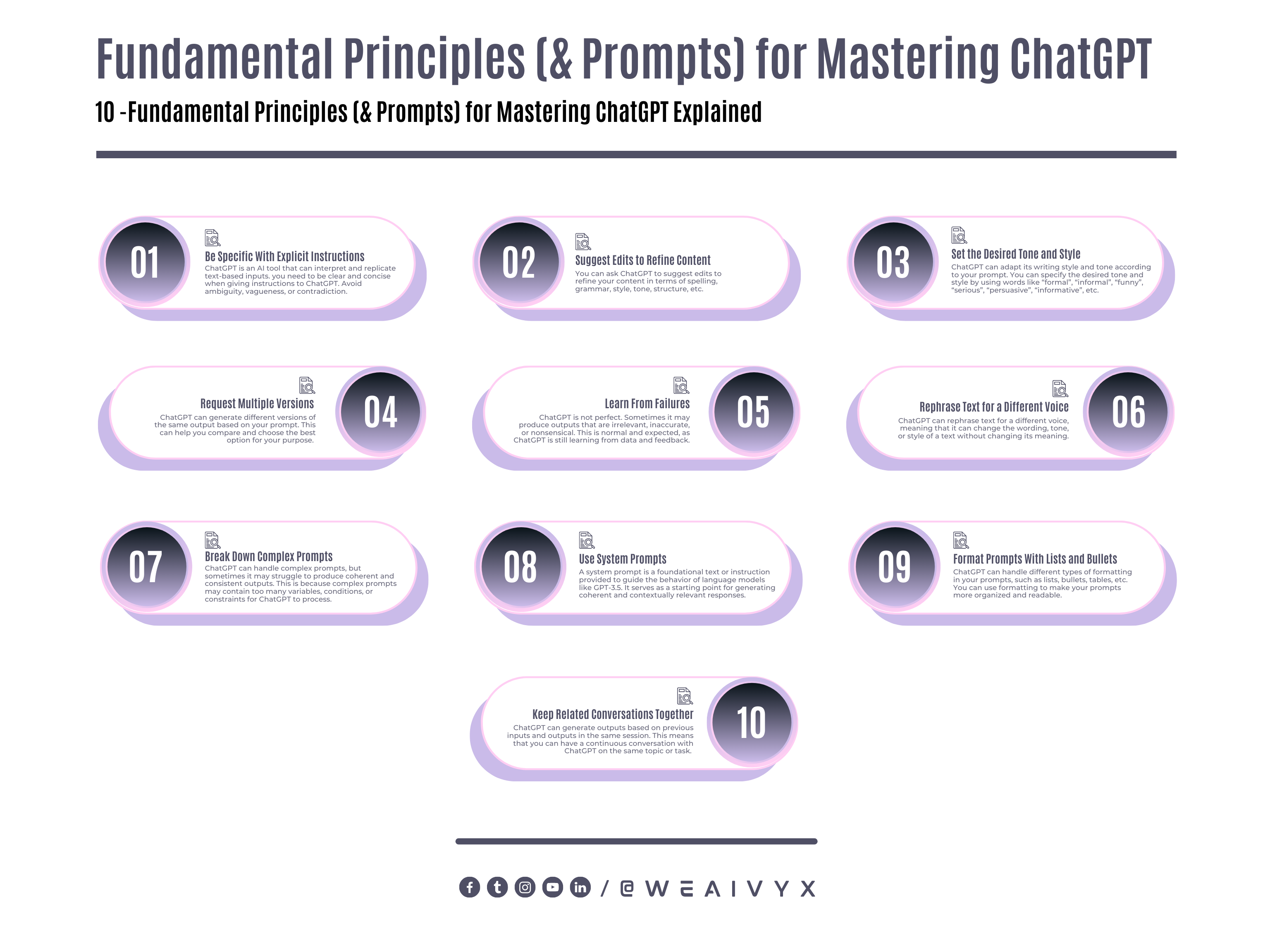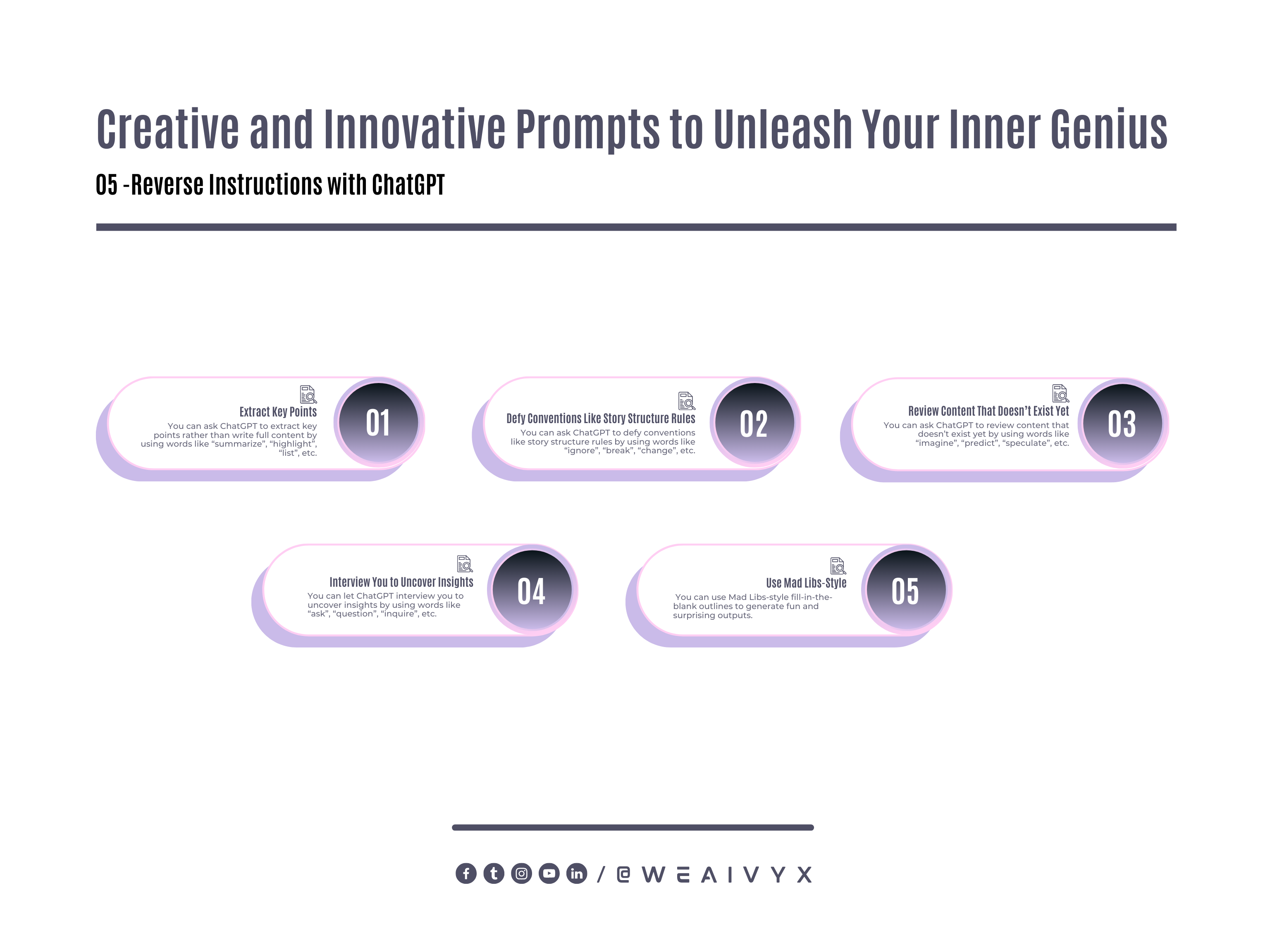Writing can be a rewarding and enjoyable activity, but sometimes it can also be challenging and frustrating.
Whether you’re a professional writer, a student, or a hobbyist, you may encounter writer’s block, lack of inspiration, or difficulty in expressing your ideas.
Fortunately, there’s a powerful and versatile tool that can help you overcome these obstacles and unleash your imagination: ChatGPT.
What Is ChatGPT
ChatGPT is an AI writing assistant that can generate amazingly human-like writing on virtually any topic with just a prompt.
You can use ChatGPT to create content, improve your writing skills, or explore new possibilities.
But how do you use ChatGPT effectively?
How do you craft prompts that will spark your creativity and produce the best results?
In this blog post, we’ll show you ingenious prompts and techniques to truly unleash your inner genius with this groundbreaking AI.
From roleplaying different perspectives to conducting imaginary debates, we’ve got plenty of practical tips to inject innovation into your content.
Let’s dive in!
Meet Your New Swiss Army Knife: ChatGPT
ChatGPT is the latest iteration of language AI created by OpenAI, built on the GPT-4 model. It’s trained on a massive amount of internet text, allowing it to generate amazingly human-like writing on virtually any topic with just a prompt.
Consider ChatGPT your personal ideation assistant – a versatile tool you can use in countless ways if you know how to wield it.
You can use ChatGPT for various purposes, such as:
Writing content for blogs, websites, social media, newsletters, etc.
Creating scripts for videos, podcasts, presentations, etc.
Transcribing audio or video files into text
Generating website code, tables, CSV files, etc.
Describing the contents of images or videos
Creating schedules, plans, outlines, etc.
Explaining concepts, terms, rules, etc.
Mimicking the writing or speech style of famous people
Summarizing long articles or books
Pulling interesting data points or insights from reports or studies
And much more! The possibilities are endless with ChatGPT. All you need is a prompt – a sentence or a paragraph that tells ChatGPT what you want it to do.
The Fundamental Principles (& Prompts) for Mastering ChatGPT
Before unleashing your creativity, you need to lay a solid foundation. Here are 10 fundamental strategies for prompting ChatGPT effectively:
1. Be Specific With Explicit Instructions
ChatGPT is an AI tool that can interpret and replicate text-based inputs. However, it’s not a human being that can understand your intentions or preferences. Therefore, you need to be clear and concise when giving instructions to ChatGPT.
Avoid ambiguity, vagueness, or contradiction. Use simple and direct language that ChatGPT can understand.
For example, instead of asking ChatGPT to “write something interesting”, ask it to “write a short story about a detective who solves a murder mystery in a futuristic city”.
The more specific you are, the more likely ChatGPT will produce the desired output.
2. Ask ChatGPT to Suggest Edits to Refine Content
ChatGPT is not only good at generating content from scratch but also at improving existing content.
You can ask ChatGPT to suggest edits to refine your content in terms of spelling, grammar, style, tone, structure, etc.
You can also ask ChatGPT to give feedback on what you did and did not like about previous iterations.
For example, you can ask ChatGPT to “proofread the below text for spelling and grammar errors” or “suggest ways to make the tone more light-hearted in this text”.
You can also ask ChatGPT to “explain why this sentence is unclear” or “tell me what I can improve in this paragraph”.
3. Set the Desired Tone and Style
ChatGPT can adapt its writing style and tone according to your prompt. You can specify the desired tone and style by using words like “formal”, “informal”, “funny”, “serious”, “persuasive”, “informative”, etc.
You can also use examples of texts that have the tone and style you want and ask ChatGPT to mimic them.
For example, you can ask ChatGPT to “write a product description for a pair of headphones in a casual and friendly tone” or “write an email to my boss in a formal and respectful tone”.
You can also ask ChatGPT to “write an article about climate change in the style of The New York Times” or “write a tweet about my new book in the style of J.K. Rowling”.
4. Request Multiple Versions of the Same Output
ChatGPT can generate different versions of the same output based on your prompt. This can help you compare and choose the best option for your purpose. You can request multiple versions by using words like “alternatives”, “options”, “variations”, etc.
For example, you can ask ChatGPT to “generate 5 title options for a blog post about the benefits of meditation” or “generate 3 alternative endings for this story”.
You can also ask ChatGPT to “generate a different version of this paragraph with more details” or “generate a shorter version of this text with fewer words”.
5. Learn From Failures and Adjust Prompts Accordingly
ChatGPT is not perfect. Sometimes it may produce outputs that are irrelevant, inaccurate, or nonsensical. This is normal, as ChatGPT is still learning from data and feedback.
Instead of giving up or getting frustrated, you can learn from these failures and adjust your prompts accordingly.
For example, if ChatGPT produces an output that is off-topic, you can try to make your prompt more specific or provide more context.
If ChatGPT produces an incorrect output, you can try to correct it or provide more facts or sources.
If ChatGPT produces an output that is illogical, you can try to rephrase it or provide more reasoning or examples.
6. Rephrase Text for a Different Voice
ChatGPT can rephrase text for a different voice, meaning that it can change the wording, tone, or style of a text without changing its meaning.
This can help you avoid repetition or boredom, as well as tailor your content to different audiences or purposes.
For example, you can ask ChatGPT to “rephrase this sentence more formally” or “rephrase this paragraph more humorously”. You can also ask ChatGPT to “rephrase this text for a younger audience” or “rephrase this text for a scientific journal”.
7. Break Down Complex Prompts Into Simpler Requests
ChatGPT can handle complex prompts, but sometimes it may struggle to produce coherent and consistent outputs.
This is because complex prompts may contain too many variables, conditions, or constraints for ChatGPT to process.
In such cases, you can try to break down complex prompts into simpler requests and combine them later.
For example, instead of asking ChatGPT to “write a 500-word essay on why democracy is the best form of government”, you can ask it to:
Write a thesis statement for the essay
Write an introduction paragraph for the essay
Write three body paragraphs for the essay, each with a topic sentence, supporting evidence, and a conclusion sentence
Write a conclusion paragraph for the essay
Write a reference list for the essay
Then you can combine these outputs into a complete essay.
8. Use System Prompts to Provide Context
A system prompt is a foundational text or instruction provided to guide the behavior of language models like GPT-3.5.
It serves as a starting point for generating coherent and contextually relevant responses.
When using a system prompt, it’s crucial to provide clear and specific instructions to convey the desired outcome.
By crafting detailed prompts, users can guide the model to generate content that aligns with their requirements.
For instance, when seeking creative writing assistance, one can use a system prompt like “Write a captivating short story about a detective solving a mysterious case in a futuristic city.”
Additionally, experimenting with different system prompts can help fine-tune the generated output, enabling users to customize the language model’s responses for various tasks, such as code generation, content creation, or problem-solving.
Overall, understanding how to effectively utilize system prompts empowers users to harness the capabilities of language models more precisely and efficiently.
9. Format Prompts With Lists and Bullets
ChatGPT can handle different types of formatting in your prompts, such as lists, bullets, tables, etc. You can use formatting to make your prompts more organized and readable. You can also use formatting to indicate the structure or layout of your desired output.
For example, you can use lists and bullets to:
Provide multiple options or alternatives for ChatGPT to choose from
Provide multiple instructions or steps for ChatGPT to follow
Provide multiple points or arguments for ChatGPT to elaborate on
Provide multiple questions or topics for ChatGPT to answer or discuss
You can also use tables to:
Provide data or information for ChatGPT to analyze or summarize
Provide input and output examples for ChatGPT to learn from
Provide templates or outlines for ChatGPT to fill in
10. Keep Related Conversations Together
ChatGPT can generate outputs based on previous inputs and outputs in the same session.
This means that you can have a continuous conversation with ChatGPT on the same topic or task.
However, if you switch topics or tasks too often, ChatGPT may lose track of the context and produce irrelevant or inconsistent outputs.
Therefore, it’s advisable to keep related conversations together and avoid jumping from one topic or task to another.
You can also use system messages like /remember or /context to remind ChatGPT of the relevant information or examples.
This will help ChatGPT maintain the coherence and consistency of your outputs.

Creative and Innovative Prompts to Unleash Your Inner Genius
Now that you’ve mastered the basics, let’s look at some advanced prompts to give your creativity a major boost:
Remix ChatGPT Prompts
Get imaginative by twisting traditional prompts in unusual ways:
Conduct Debates to Explore Multiple Angles
You can use ChatGPT to conduct debates on various topics or issues, either with yourself or with another person.
You can ask ChatGPT to take a stance on a topic and provide arguments and evidence to support it.
You can also ask ChatGPT to respond to counterarguments or questions from the opposing side. This can help you explore multiple angles and perspectives on a topic, as well as improve your critical thinking and persuasion skills.
For example, you can ask ChatGPT to:
Debate with me whether social media is good or bad for society
Debate with yourself whether you should quit your job or not
Debate with another person whether aliens exist or not
Shift Perspectives by Roleplaying Different Identities
You can use ChatGPT to shift perspectives by roleplaying different identities, such as fictional characters, historical figures, celebrities, animals, etc.
You can ask ChatGPT to write or speak as if you were someone else and describe their thoughts, feelings, actions, etc.
You can also ask ChatGPT to interact with other characters or people as if you were someone else.
This can help you develop empathy and understanding for others, as well as enhance your imagination and creativity.
For example, you can ask ChatGPT to:
Write a diary entry as if you were Harry Potter
Speak as if you were Abraham Lincoln
Interact with a customer as if you were Elon Musk
Brainstorm Ideas Through AI-Assisted Dialogues
You can use ChatGPT to brainstorm ideas through AI-assisted dialogues, either with yourself or with another person.
You can ask ChatGPT to generate ideas for various purposes, such as content creation, product development, problem-solving, etc.
You can also ask ChatGPT to evaluate, refine, or expand on your ideas. This can help you generate more and better ideas, as well as stimulate your creativity and innovation.
For example, you can ask ChatGPT to:
Generate 10 blog post ideas for my website
Evaluate my idea for a new app
Expand on my idea for a short story
Explain Concepts Simply by Pretending You’re Five
You can use ChatGPT to explain concepts simply by pretending you’re five years old.
You can ask ChatGPT to explain complex or abstract concepts in simple and easy-to-understand terms, using examples, analogies, or stories.
You can also ask ChatGPT to ask questions or express curiosity about the concepts.
This can help you simplify and clarify your understanding of the concepts, as well as make them more engaging and memorable.
For example, you can ask ChatGPT to:
Explain what quantum physics
Explain what is love
Ask questions about what is democracy
Embrace Contrasts by Describing Opposites
You can use ChatGPT to embrace contrasts by describing opposites of various things, such as words, phrases, sentences, paragraphs, etc.
You can ask ChatGPT to reverse the meaning, tone, or style of the original text by using antonyms, negations, or inversions.
You can also ask ChatGPT to compare and contrast the original text and the opposite text.
This can help you explore different possibilities and perspectives, as well as enhance your vocabulary and expression skills.
For example, you can ask ChatGPT to:
Describe the opposite of happiness
Describe the opposite of this sentence: “She was a beautiful princess who lived happily ever after.”
Compare and contrast this paragraph and its opposite: “He was a brave hero who fought valiantly against the evil forces.”

Reverse Instructions with ChatGPT
Flip prompts on their head to gain refreshing new outlooks:
Ask ChatGPT to Extract Key Points Rather Than Write Full Content
ChatGPT can write full content based on your prompt, but sometimes you may only need the key points or the main idea.
You can ask ChatGPT to extract key points rather than write full content by using words like “summarize”, “highlight”, “list”, etc.
For example, you can ask ChatGPT to:
Summarize the main argument of this article
Highlight the most important facts from this report
List the main features of this product
Defy Conventions Like Story Structure Rules
ChatGPT can follow conventions like story structure rules, but sometimes you may want to break them for creative purposes.
You can ask ChatGPT to defy conventions like story structure rules by using words like “ignore”, “break”, “change”, etc.
For example, you can ask ChatGPT to:
Ignore the rule of three and write a story with five acts
Break the fourth wall and write a story where the narrator talks to the reader
Change the point of view and write a story from the villain’s perspective
Have ChatGPT Review Content That Doesn’t Exist Yet
ChatGPT can review content that already exists, but sometimes you may want to get feedback on content that doesn’t exist yet.
You can ask ChatGPT to review content that doesn’t exist yet by using words like “imagine”, “predict”, “speculate”, etc.
For example, you can ask ChatGPT to:
Imagine that I wrote a book about my life and write a review for it
Predict how people will react to my new song and write a comment for it
Speculate what critics will say about my new movie and write a quote for it
Let ChatGPT Interview You to Uncover Insights
ChatGPT can answer your questions, but sometimes you may want to ask yourself questions to uncover insights.
You can let ChatGPT interview you to uncover insights by using words like “ask”, “question”, “inquire”, etc.
For example, you can let ChatGPT:
Ask me 10 questions about my goals and motivations
Question me about my strengths and weaknesses
Inquire about my passions and hobbies
Use Mad Libs-Style Fill-in-the-Blank Outlines
ChatGPT can fill in the blanks in your prompts, but sometimes you may want to create your blanks for creative purposes.
You can use Mad Libs-style fill-in-the-blank outlines to generate fun and surprising outputs.
You can use words like “noun”, “verb”, “adjective”, etc., or more specific categories like “name”, “color”, “animal”, etc., to create blanks.
For example, you can use Mad Libs-style fill-in-the-blank outlines to:
Write a funny joke: What do you call a _____ that _____? A _____!
Write a catchy slogan: Just _____ it!
Write a silly poem: Roses are ____, violets are ____, sugar is ____, and so are you!

Conclusion
ChatGPT is an AI writing assistant that can generate amazingly human-like writing on virtually any topic with just a prompt.
You’ve also discovered ingenious prompts and techniques to truly unleash your inner genius with this groundbreaking AI.
From roleplaying different perspectives to conducting imaginary debates, you’ve got plenty of practical tips to inject innovation into your content.
Now it’s time to put these tips into action and see what amazing things you can create with ChatGPT.
Whether you want to write a story, a poem, an essay, a song, or anything else, ChatGPT can provide you with a variety of prompts to get you started.
You can also customize the prompts to suit your preferences and style.
ChatGPT is not only a fun and creative way to practice your writing skills, but also a powerful tool to generate original and engaging content.
Try it out today and see for yourself why ChatGPT is the ultimate AI writing assistant for unleashing your imagination!
